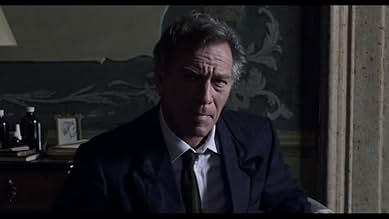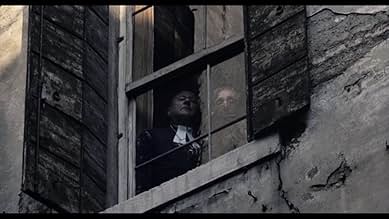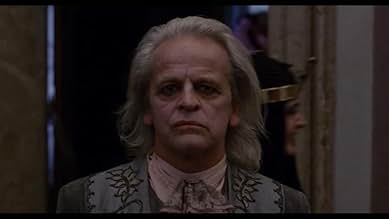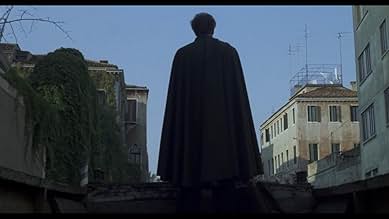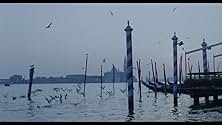PUNTUACIÓN EN IMDb
5,1/10
1,9 mil
TU PUNTUACIÓN
El profesor Paris Catalano visita Venecia para investigar la última aparición conocida del famoso vampiro Nosferatu durante el carnaval de 1786.El profesor Paris Catalano visita Venecia para investigar la última aparición conocida del famoso vampiro Nosferatu durante el carnaval de 1786.El profesor Paris Catalano visita Venecia para investigar la última aparición conocida del famoso vampiro Nosferatu durante el carnaval de 1786.
- Dirección
- Guión
- Reparto principal
Maria Cumani Quasimodo
- Princess
- (as Maria Clementina Cumani Quasimodo)
La Chunga
- Woman at Gypsy Camp
- (as Micaela Flores Amaya 'La Chunga')
Mickey Knox
- Priest
- (sin acreditar)
Reseñas destacadas
I recently watched the Italian film 🇮🇹 Nosferatu in Venice (1985) on Prime. The storyline follows a man tracking down Nosferatu and arriving in Venice, where he believes the vampire is hiding. He hears tales that Nosferatu wishes to die, and the man is willing to help him achieve that goal.
The film is co-directed by Augusto Caminito (White Hunter) and Klaus Kinski (Paganini), who also stars in the film. It also features performances from Barbara De Rossi (Blood Ties), Yorgo Voyagis (Frantic), Elvire Audray (Ironmaster), Christopher Plummer (12 Monkeys), and Donald Pleasence (Halloween).
Overall, this is a very average movie, but there were some elements that I enjoyed. The opening arrival sequence and overall cinematography are gorgeous, with the beautiful settings in Venice adding a lot to the visuals. The storyline is fairly straightforward and not overly imaginative. The kills are average, and the horror elements rely more on setting and atmosphere, though there is a fun fall scene. The background music does a solid job of establishing the mood. The female lead is stunning, and there's some classic Italian nudity. While the poetic ending didn't quite land for me as intended, there was a fun twist that I appreciated.
In conclusion, Nosferatu in Venice is an average addition to the horror genre but might be worth watching for horror enthusiasts looking for something different. I'd give this a 5/10 and recommend it only with the appropriate expectations.
The film is co-directed by Augusto Caminito (White Hunter) and Klaus Kinski (Paganini), who also stars in the film. It also features performances from Barbara De Rossi (Blood Ties), Yorgo Voyagis (Frantic), Elvire Audray (Ironmaster), Christopher Plummer (12 Monkeys), and Donald Pleasence (Halloween).
Overall, this is a very average movie, but there were some elements that I enjoyed. The opening arrival sequence and overall cinematography are gorgeous, with the beautiful settings in Venice adding a lot to the visuals. The storyline is fairly straightforward and not overly imaginative. The kills are average, and the horror elements rely more on setting and atmosphere, though there is a fun fall scene. The background music does a solid job of establishing the mood. The female lead is stunning, and there's some classic Italian nudity. While the poetic ending didn't quite land for me as intended, there was a fun twist that I appreciated.
In conclusion, Nosferatu in Venice is an average addition to the horror genre but might be worth watching for horror enthusiasts looking for something different. I'd give this a 5/10 and recommend it only with the appropriate expectations.
Nosferatu in Venice (1988)
** (out of 4)
Klaus Kinski returns to the role of Nosferatu in this Italian film that was originally suppose to be a follow-up to Herzog's 1979 film. After various production issues including two director's being fired, the film ended up pretty much being 100% on its own with the only connection to the earlier film being Kinski. In the film, vampire hunter Paris Catalano (Christopher Plummer) travels to Venice, the last known location of the vampire Nosferatu (Kinski). Catalano tries to locate the whereabouts of the vampire who he believes has a desire to finally die. This is a rather interesting failure that has a lot going for it but it's obvious the production issues caused a lot of problems especially during the first part of the movie. The film starts off very ambitious as it centers on the Plummer character in current times but we then have several flashbacks to the earlier days of Nosferatu and how he became who he is. This was an interesting idea but it never really works for several reasons and one of them is a bizarre rock score that doesn't fit anything we see. Another reason these flashbacks never work is because at times it's hard to follow what exactly is going on and why certain flashbacks might be happening. Then, around the fifty-minute mark, something strange happens and the film actually turns extremely entertaining as Nosferatu finds himself in current times and falling in love with a young black lady who might just hold the key to his eventual death. Yes, Kinski drove several directors away from the film and this is partly to blame of the uneven film but you also have to give him credit because he turns in a great performance. He has his long blonde hair flowing and there's no chalk make-up so we get to see this Nosferatu in a very human-like state and the actor makes us feel sorry for this person who simply won't die. I found Kinski really intense throughout the film and this certainly spills over for several entertaining scenes but I think the romantic side works the best. Plummer is also pretty good in his rather thankless role and we even get Donald Pleasence in a role but he's pretty much wasted. Barbara De Rossi and Anne Knecht are both good as the ladies in the pack. Augusto Caminito, Mario Caiano, Luigi Cozzi and Maurizio Lucidi all did some work on the film but it was Caminito who ended up shooting the majority of the film. Even Kinski was apparently in charge of directing his scenes so who knows what was really going on with this production. It's certainly a very troubled movie but at the same time there's just so much here that does work in the end. We get some rather strong atmosphere and being 1988 and from Italy, there's much more sex, nudity and blood than normal, which is a plus. I doubt art house fans are going to enjoy this thing but if you're a horror fan and like Kinski then it would be worth your time to check this out. It's certainly not going to replace the Herzog film but it's an interesting little movie.
** (out of 4)
Klaus Kinski returns to the role of Nosferatu in this Italian film that was originally suppose to be a follow-up to Herzog's 1979 film. After various production issues including two director's being fired, the film ended up pretty much being 100% on its own with the only connection to the earlier film being Kinski. In the film, vampire hunter Paris Catalano (Christopher Plummer) travels to Venice, the last known location of the vampire Nosferatu (Kinski). Catalano tries to locate the whereabouts of the vampire who he believes has a desire to finally die. This is a rather interesting failure that has a lot going for it but it's obvious the production issues caused a lot of problems especially during the first part of the movie. The film starts off very ambitious as it centers on the Plummer character in current times but we then have several flashbacks to the earlier days of Nosferatu and how he became who he is. This was an interesting idea but it never really works for several reasons and one of them is a bizarre rock score that doesn't fit anything we see. Another reason these flashbacks never work is because at times it's hard to follow what exactly is going on and why certain flashbacks might be happening. Then, around the fifty-minute mark, something strange happens and the film actually turns extremely entertaining as Nosferatu finds himself in current times and falling in love with a young black lady who might just hold the key to his eventual death. Yes, Kinski drove several directors away from the film and this is partly to blame of the uneven film but you also have to give him credit because he turns in a great performance. He has his long blonde hair flowing and there's no chalk make-up so we get to see this Nosferatu in a very human-like state and the actor makes us feel sorry for this person who simply won't die. I found Kinski really intense throughout the film and this certainly spills over for several entertaining scenes but I think the romantic side works the best. Plummer is also pretty good in his rather thankless role and we even get Donald Pleasence in a role but he's pretty much wasted. Barbara De Rossi and Anne Knecht are both good as the ladies in the pack. Augusto Caminito, Mario Caiano, Luigi Cozzi and Maurizio Lucidi all did some work on the film but it was Caminito who ended up shooting the majority of the film. Even Kinski was apparently in charge of directing his scenes so who knows what was really going on with this production. It's certainly a very troubled movie but at the same time there's just so much here that does work in the end. We get some rather strong atmosphere and being 1988 and from Italy, there's much more sex, nudity and blood than normal, which is a plus. I doubt art house fans are going to enjoy this thing but if you're a horror fan and like Kinski then it would be worth your time to check this out. It's certainly not going to replace the Herzog film but it's an interesting little movie.
In VAMPIRE IN VENICE, Professor Paris Catalano (Christopher Plummer) is obsessed with tracking down the infamous blood-drinker of the title (Klaus Kinski). When Catalano finds a strange family in Venice, who were originally from Transylvania, he believes he's hit pay dirt.
This leads to the backstory being told, while Donald Pleasence makes an appearance.
When a medium is called in, resulting in a seance, the so-called "Prince of Putridity" returns! Death and doom are the result!
Kinski is quite convincing and threatening in his undead role. His interesting facial features have always made him the perfect villain, whether in horror or crime thrillers. He pulls off being pure eeevil with ease! Plummer is doggedly heroic as the Van Helsing-like Catalano.
While not a bad movie, it does tend to drag on interminably in spots...
This leads to the backstory being told, while Donald Pleasence makes an appearance.
When a medium is called in, resulting in a seance, the so-called "Prince of Putridity" returns! Death and doom are the result!
Kinski is quite convincing and threatening in his undead role. His interesting facial features have always made him the perfect villain, whether in horror or crime thrillers. He pulls off being pure eeevil with ease! Plummer is doggedly heroic as the Van Helsing-like Catalano.
While not a bad movie, it does tend to drag on interminably in spots...
This not-exactly-a-sequel to Herzog's remake, though with Kinski in the same role (albeit without the distinctive makeup-he apparently just refused to wear it again) is much better produced than the vast majority of 1980s Italian horror movies. The locations, costuming and photography are well above average, making the whole enterprise seem at least halfway to being a truly a quality effort. But despite that, and the fairly prestigious cast, the script runs a narrow gamut between the pedestrian and the messy, with some story continuity so weak you have to wonder if major scenes were left unfilmed, and the whole had to be patched together as well as possible in the editing room. (That wouldn't be surprising, as the producer went through several directors before deciding to take the job himself. Given the resulting production delays, his directorial inexperience, and the inevitable Kinski behavior problems, it seems likely the shoot was heavily compromised.)
Anyway, this movie is a bit of an attractive mess, jumbling together flashbacks, flamenco interludes, sexploitation, several deaths by fang, several others by fence-spike, a brief incongruous "Superman"-esque flying scene, and no coherent fix on the vampire's powers at all. (He seems to command wind, while having no particular problem with crosses or daylight.) Kinski walks though the movie looking aged-rockstar-cool (save when his fangs make him a little too Bugs Bunny-ish), Christopher Plummer (as a Van Helsing type) looks like he can't wait to fire the agent who got him here, but still feels professionally obligated to pretend to take his part seriously. Donald Pleasance simply seems superfluous; even when whipped into a ranting frenzy, he doesn't quite seem germane to the plot, such as it is.. Yorgo Voyagis, who may have been great in Greek cinema for all I know, is wooden once again in an international production. Barbara De Rossi looks very beautiful, which is all her part requires. (Well, that and a whole lot of nudity.)
Sometimes "Nosferatu in Venice" seems like it's aiming for some kind of melancholy pathos, sometimes just for rote thrills and kills (none very effectively done). Throughout the visual presentation has a certain poetical sumptuousness. (Kudos to the location scout-you can tell the film's largely 18th-century interiors are real places, not studio sets.) It doesn't make the leap to actual poetry, though, because the script is such a patch job. It's hard to tell just what the writer-director originally had in mind, because the film definitely has elements of an ambitious vision, but also major signs of having only realized that vision in part. So, not a good movie-but an interesting and watchable failure.
Anyway, this movie is a bit of an attractive mess, jumbling together flashbacks, flamenco interludes, sexploitation, several deaths by fang, several others by fence-spike, a brief incongruous "Superman"-esque flying scene, and no coherent fix on the vampire's powers at all. (He seems to command wind, while having no particular problem with crosses or daylight.) Kinski walks though the movie looking aged-rockstar-cool (save when his fangs make him a little too Bugs Bunny-ish), Christopher Plummer (as a Van Helsing type) looks like he can't wait to fire the agent who got him here, but still feels professionally obligated to pretend to take his part seriously. Donald Pleasance simply seems superfluous; even when whipped into a ranting frenzy, he doesn't quite seem germane to the plot, such as it is.. Yorgo Voyagis, who may have been great in Greek cinema for all I know, is wooden once again in an international production. Barbara De Rossi looks very beautiful, which is all her part requires. (Well, that and a whole lot of nudity.)
Sometimes "Nosferatu in Venice" seems like it's aiming for some kind of melancholy pathos, sometimes just for rote thrills and kills (none very effectively done). Throughout the visual presentation has a certain poetical sumptuousness. (Kudos to the location scout-you can tell the film's largely 18th-century interiors are real places, not studio sets.) It doesn't make the leap to actual poetry, though, because the script is such a patch job. It's hard to tell just what the writer-director originally had in mind, because the film definitely has elements of an ambitious vision, but also major signs of having only realized that vision in part. So, not a good movie-but an interesting and watchable failure.
I haven't seen this film for years but it has left lasting images and atmospheres in my mind. I seem to recall the score being really interesting aswell. The camera and cinematography from what i can remember was amazing.- Showing gondalas sailing through the fog in Venice, a stunning location to say the least. It also boasts one of the prettiest actress's ever, in the shape of De Rossi. All this together with Kinski creeping around as Nosferatu makes for essential viewing.
¿Sabías que...?
- CuriosidadesProducer Augusto Caminito originally hired director Maurizio Lucidi, who shot a few crowd scenes in Venice before the script had even been completed. Caminito decided that the project needed another director and fired Lucidi (paying him his full salary), hiring Pasquale Squitieri to write and direct the picture. However, Squitieri's screenplay proved too expensive to shoot so Caminito decided to stop working with him (he nevertheless paid him his full, hefty, salary). Shooting had already been postponed several times and the Italian TV network which co-produced the film was getting nervous. So Caminito hired a third director, B-movie veteran Mario Caiano, and shooting could start. On his first day, Klaus Kinski got into a violent argument with Caiano and refused to work with him. The director then agreed to leave the set (after being paid his full salary), the third director to leave the picture before principal photography was complete. Facing disaster, producer Augusto Caminito then decided to direct the film himself so he wouldn't have to pay another director. Since he had almost no directing experience, he was helped by his assistant Luigi Cozzi. Kinski also reportedly directed some scenes himself.
- PifiasWhile reading from the old text, Christopher Plummer pronounces the word "compare" as "com-pair," following English pronunciation. However, the Latin or Italian word "compare" should be pronounced "com-pa-reh," with each syllable distinctly enunciated and the final "e" softly pronounced. In Italian, "compare" means "godfather" or "companion," and the mispronunciation is particularly noticeable, given the historical and linguistic context of the text.
- ConexionesFeatured in FantastiCozzi (2016)
Selecciones populares
Inicia sesión para calificar y añadir a tu lista para recibir recomendaciones personalizadas
- How long is Vampire in Venice?Con tecnología de Alexa
Detalles
- Duración
- 1h 37min(97 min)
- Mezcla de sonido
- Relación de aspecto
- 1.85 : 1
Contribuir a esta página
Sugerir un cambio o añadir el contenido que falta

